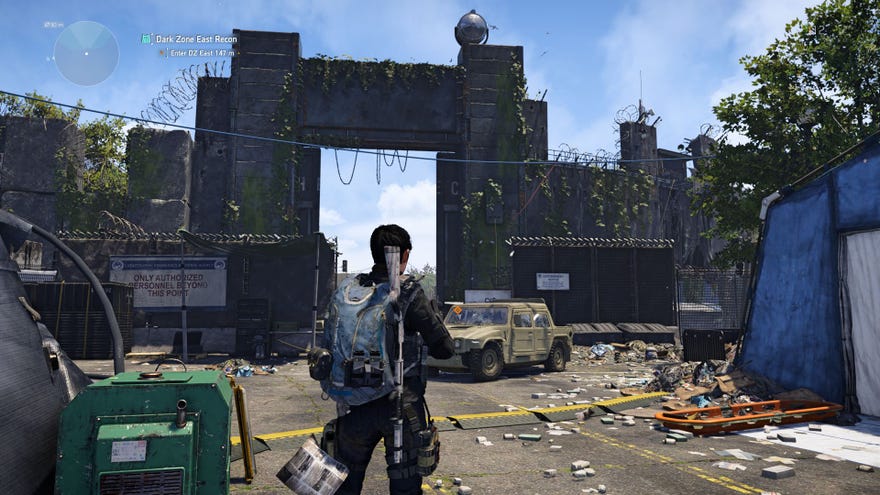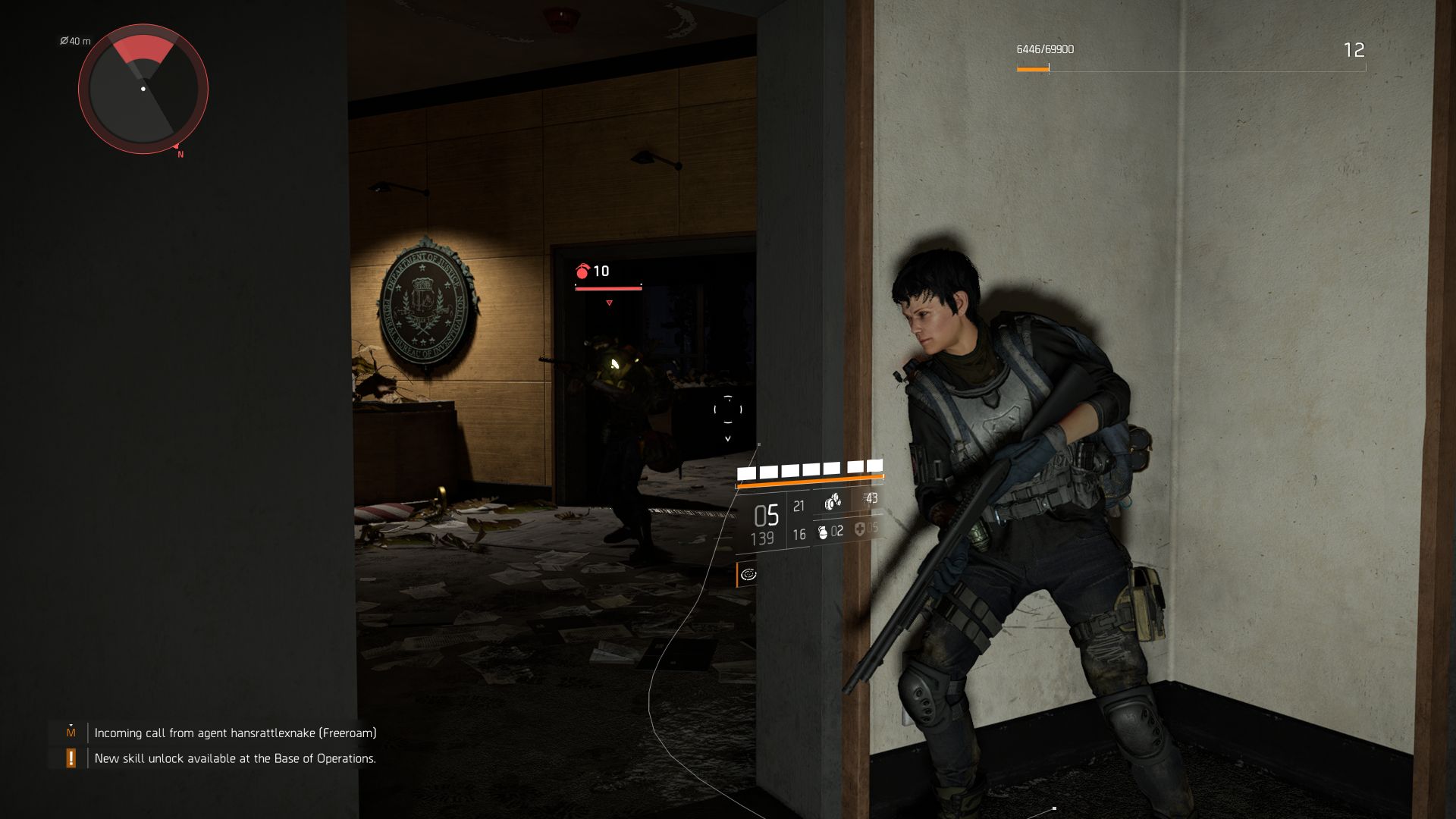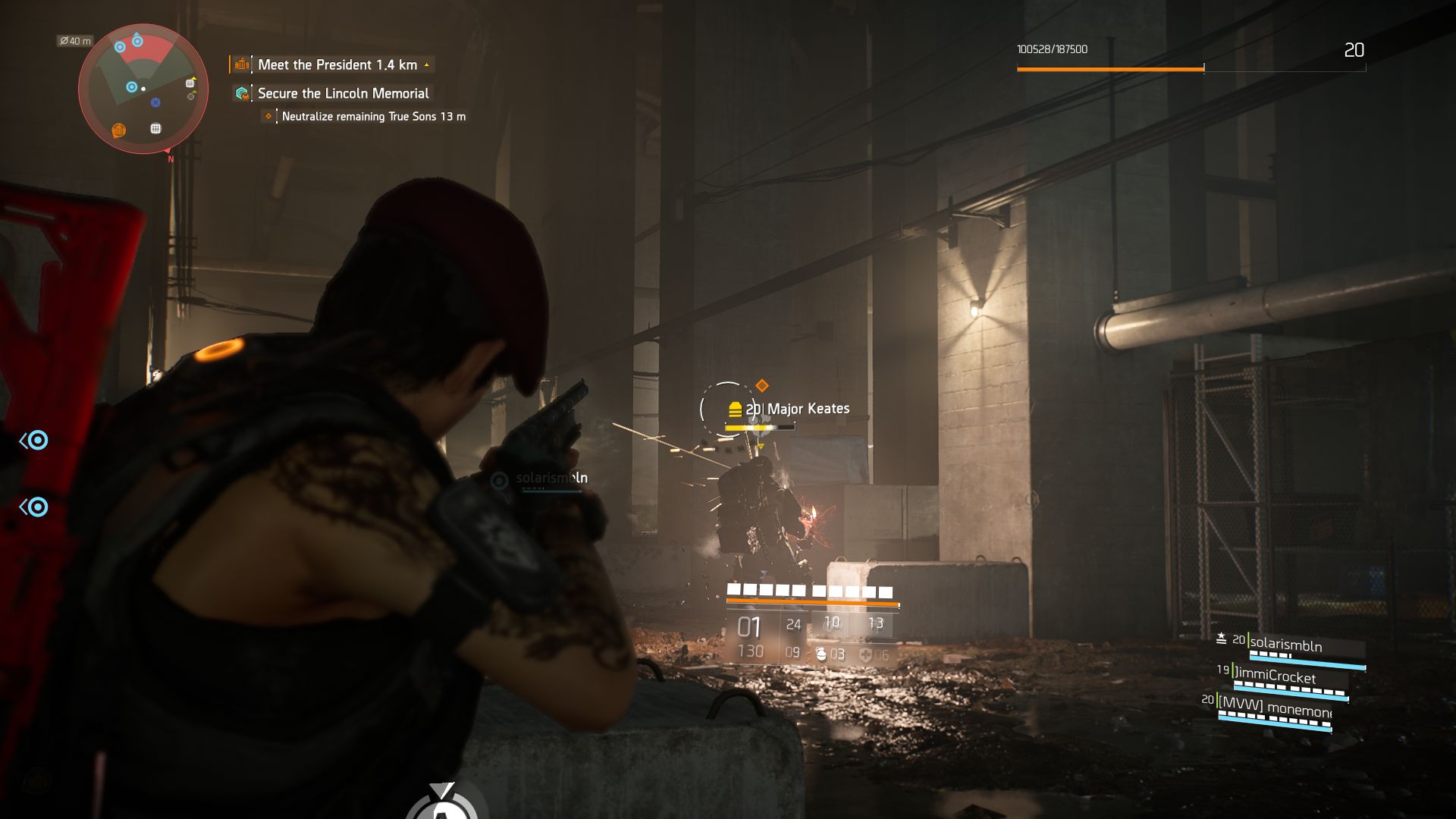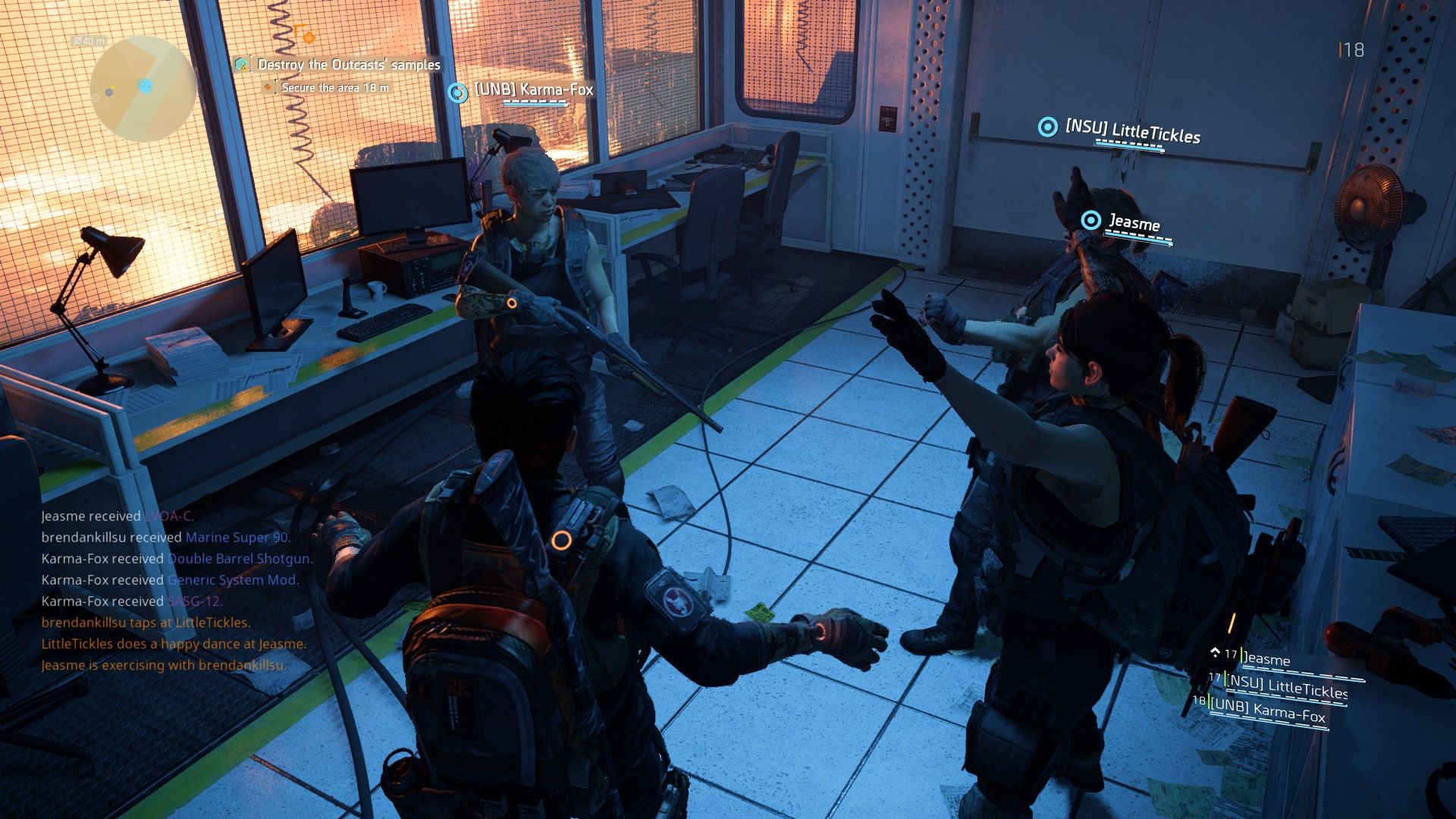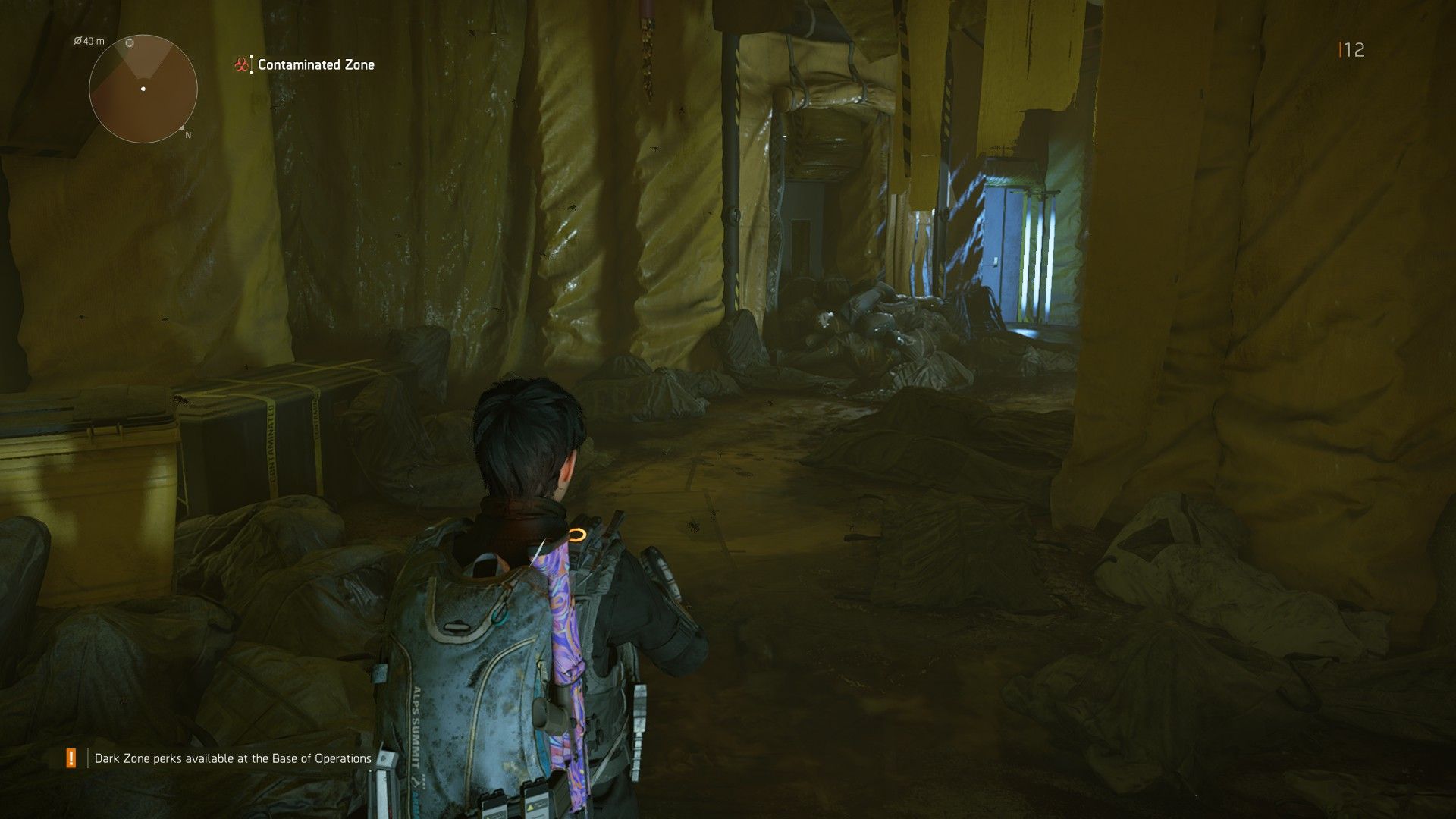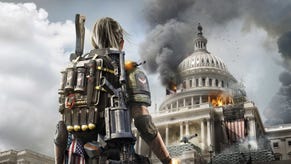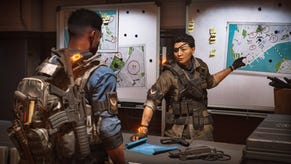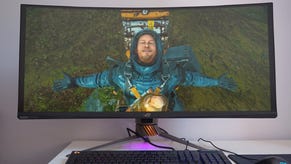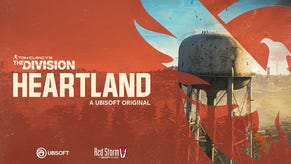Wot I Think: The Division 2
Judging by the cover
Nero played the fiddle as Rome burned, we’re told. If only he could see The Division 2’s Washington DC, a city that has been on fire for seven months. He’d be so happy. This is a shooter about taking pleasure in the ruination of a superpower. The United States is falling to bits and it’s your job to fix it “block by block” (side mission by side mission). It’s an excellent timewaster, and like many Clancyromps, you won’t come out of it moved or bettered. You’ll just come out at 1am, wondering what happened to Saturday. It’s a brash run ‘n’ gun about killing angry men who bleed numbers. A trashy target range that has you admiring purple kneepads even as the city smolders around you. If Nero were a character in The Division 2, he would need to perform a whole set of stadium country music on the steps of the Capitol just to evoke an equivalent contrast.
You’re revelling in this chaos because chaos gives you new shotguns, holsters and sunglasses, but more on the loot later. For now, just know that it follows The Division of 2016 in both form and atmosphere. The world has been struck by a virus and the subsequent breakdown of law and order has left it in ruins. We're not in New York anymore and it’s not snowing this time (it’s summer now) but the Christmas trees and gifts are still visible even in the sunshine of DC. You run around the streets in third-person, snapping to cover with a press of a button, and shooting your rifle at various terrible people over the tops of burnt-out cars and overturned bins.
Basically, your job is to clear the city of armed scum. Some missions are story-focused explodathons in which you chase down named antagonists and kill them because that’s what the man on the radio told you to do. Side missions are shorter battles but still relegated to their chunk of city space. A story mission might see you blasting through the ruins of the Air and Space Museum, for example, while a side mission might have you investigating a beekeeper’s residence. Both involve a lot of shooting.
There’s a bunch of other tasks, of course. Control points, like those of the Far Cry series, can be liberated from bad dudes. Safe houses can be unlocked, revealing caches of “SHD tech” (the magical technocurrency that lets you upgrade your turrets and seeker-grenades, just two of the skills you can use between cooldowns). There are "settlements" too. These are special bases which unlock more side missions and change in appearance as you expunge the surrounding streets of evil men with red health bars. A settlement might look like a ramshackle assortment of sad huts when you first arrive. But by the time you clear out the nearby factions, they will have added so many farm plots and produce stands, it will look like the farmer’s market down the posh end of town.
Altogether, it’s the classic Ubisoft quest to turn a map stained red into a nice friendly green, but given a lick of humanity. A reminder that what you’re doing is going somewhere and improving people’s lives (even if it is implausible that a post-apocalyptic township would invest in a concert stage).
Of course, this is also a quest for loot. Much of your time is spent rummaging around for better gear. A submachine gun with better critical hit damage, a chestplate that improves your healer drone (another skill), or just a nice beret to match your aviators. In this sense, it’s a min-maxers dream. The amount of gear dropped by enemies is almost paralysing, and there is a lot of MMO trickery to keep you on the loot wheel. You can deconstruct gear you don’t want into fabric. You can use materials to craft gear at a table in the White House (the White House is your HQ). You can smush old sniper rifles into a “recalibration” desk so that a different, better sniper rifle will be able to reload faster.
You’re likely to spend as much time fiddling with gear and menus as you do fighting the nasty creeps who live in Foggy Bottom. But the tweaking of these menus is compelling in its own way. It’s that old MMO jigsaw of efficiency, trying to find the right helmet to go with your backpack so you can do a silly amount of extra damage with your revolver. A fashion puzzle for murderers. Although the orange exclams that pop up to denote new items makes me wish there was some kind of “mark all as read” button.
Anyway! Enough about menus, it’s the pew-pewing of furious war boys that keeps this going. As a cover shooter it’s remarkably robust, as solid as a good wall of concrete. Enemies feel smart and will make noticeable efforts to flank you. And each baddie acts according to the helpful icon floating over their head. LMG heavies will set up a machinegun and bully you with gunfire, making it hard to break cover. Shotgunners will rush you, grunts will flank, grenadiers lob petrol bombs, medics will revive their fallen comrades. There is one enemy who sends out little RC cars with explosives or blades attached, and this type of soldier always seems to scarper as soon as he sees you coming, a delightful coward.
It’s a colourful firing range full of wonderful jerks. Several shootouts left me grinning with admiration for these gun-toters and all their retreating, repositioning and rescrambling. Their gun-swapping, their well-placed turrets. They are sneaky, pushy and smart. In weaker moments the fights can feel erratic, as you are farcically chased around the battlefield by a bulletproof man with a hammer. And once in a while, baddies have an annoying habit of bursting through a door next to you in a four-person dog-pile, triggering a Benny Hill chase with bullets and a wild, ill-fated scramble for more satisfactory cover. After one of these dumb encounters, I heard the cheerful cry of a friendly NPC. “You never know when more will show up!” She’s right. You won’t.
However, those silly moments are seldom. And the best skirmishes go to the cusp of being overwhelming, without actually tipping over into frustration. They are gunbrawls of pressure and flow, and the best almost left me out of breath. There are some age-old annoyances, like escort missions where you have to keep fragile people safe from hardened murderers. Or silly men who run at you and explode (a pet peeve). Some set pieces have cover that feels too sparse to deal with the 8 bulletfiends rushing you down. And a couple of bugs can sour things at random (shout out to this particularly debilitating bug, which left me with a malfunctioning robo-turret in the worst possible moments).
But mostly, this is darned good flanky-shooty. You might enter a long atrium and be sprayed with bullets from a heavy gunner sitting thirty metres away – a big guy with a LMG. You’ll shunt from pillar to pillar, out-thinking and dispatching riflemen along the way, only to finally creep up on the big fella hitting his gun and muttering “C’mon, load!” Your final shotgun blast is like a full stop.
In story missions, where I would often join other players, this play-soldiering is just as exciting. One of us would storm up with a shield raised, while another might snipe from a balcony. Meanwhile I would scuttle forward like a rat with my shotgun. At the end of a mission, players often do the Destiny thing of giving thanks via emote. Some would salute. I am fond of tap-dancing.
On the strength of its flanking and counter-flanking alone, I’m happy to recommend this shoot-to-loot to anyone who’s hankering for a strong example from a famously over-subscribed genre. But it has more going for it than that. This is also a world of detail and atmosphere. You leave behind dusty bootprints as you walk, and can make out the sound of bullet casings hitting the floor as you fire. Axes are buried in doors, abandoned mid-scavenge. In the beta, I found a dead man behind a bar with his dog lying next to him, also dead.
I was more intrigued by the untold story of this man and his pooch than I was in the blando Rambo mission statements of my Division. I mean that both as a criticism of the main story (it is dreadful) and as high praise to the environmental artists who have put this DC together. It’s an intricate post-apocalypse, full of windows to clamber through, rooftops to crouch across and sewers to creep around in. It’s almost a pity that there is so much loot everywhere, because it means your eyes are scanning for glowy orange boxes, when they could be appreciating the fire trucks abandoned next to the burnt trees, the mice darting across the safehouse floor.
Best among this world of detail are the quarantine zones, where you’ll find no bandits, but plenty of gloom and audio diaries. These buildings encased in yellow warn-o-plastic are islands of quiet post-disaster storytelling in a sea of shootiness. Nothing attacks you in these moody hallways, they’re just places you can visit if you want to feel unsettled at the scale of humanity’s ruination. They feel like an olive branch to singleplayer types who want to slow things down and explore. One of them is an old natural history museum, where the huge model of a mammoth looks over a disturbing amount of body bags. I wish more of DC had the confidence to throw away the waist-high cover and let the player take in the horror of a capital city gone to shit. Because the atmosphere of these yellow ghost houses makes them some of the best scenes in the game.
As for the other scenes, well. We’ve seen Ubisoft struggling to decide whether or not the game is “political” (spoiler: it is). But it’s probably best to turn off any part of your brain that’s looking for a sensible message buried underneath it all. It is political only in that scattershot way of many blockbuster bulletfests. When I invoked country music Nero earlier, that might have seemed ridiculous as critical analogies go. But a yee-hawing Roman emperor singing “I’m On Fire” is perfectly in line with The Division 2’s spray-and-pray approach to symbolism.
There are nods and nudges and winks to currents affairs, both in the cinematics and larger world. Desiccated flags, lines of dialogue about ineffectual politicians, important chess pieces knocked off important tables by upset characters. One of the Presidents in the early days of the apocalypse is called “President Waller”. In one mission, you fight through the Museum of News and Media, hosting an exhibition on US elections throughout history. Several giant screens are zapped by an EMP blast and you see the word “truth” being distorted with digital noise. Wow, game done made me think. Ultimately, it’s difficult to see what The Division 2 is trying to say with any of these messy gestures, aside from “yes, I have seen the news.”
Thankfully, you can just let all this wash over you, and this is what I have largely done. You can try to decode the meaning of it all if you like, but me? I’m going over here to throw an angry robot at the bad man. Many other reviews will likely tackle the political half-heartedness of its story. But not me, not this week. Sometimes, it’s better to leave the incessant chatter of current affairs quarantined in our everyday lives.
I find it better to approach this as a good waste of time, a detailed disasterworld to saunter through for a couple of weeks. After 36 hours, I still haven’t hit level 30, and I’ve barely touched the Dark Zone (one of my favourite places to visit in the last game), so there may be more Division thoughts to come. Suffice to say, I’m enjoying it more than its predecessor. It is chunky, it is moreish, and every time I come back to it in the evening it is like taking a big bite out of one of those mega Snickers you can only find in the cinema. All this praise might seem out of place moments after critiquing the game’s toothless practice of political commentary by obfuscation. But honestly, don’t worry about that. We humans are idiot creatures of contradiction, and we can thoroughly enjoy a rock solid shooter even as we recognise it as being vapid hogwash.
So unless you have a sincere and good-natured fondness for over-analysing media, the wall of quasi-political noise is best ignored. Then you can concentrate on what is good about this looty-shooty. The triumph of flanking a clueless rifleman, the delight of finding a gaudy new baseball cap in the gutter. The joy of being a superhuman Nero, tap-dancing on an ambulance as DC burns.
